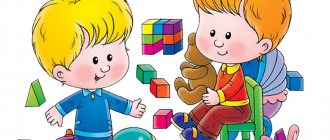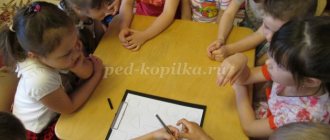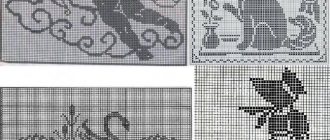Goals and objectives
The goal of the “Make a Sentence” game is to develop the lexical elements of speech and improve grammatical structure.
Tasks:
- expansion of individual vocabulary;
- learning the skill of composing simple and prepositional sentences;
- developing the ability to select homogeneous members, as well as qualities and actions for objects;
- learning the skill of expanding a sentence by adding different members;
- development of coherent speech, the ability to build a dialogue, answer and ask questions in detail and competently;
- vocabulary enrichment;
- development of imagination.
Members of the sentence: where to start?
The first place to start is to define what a proposal is. These are several words that are connected logically and intonationally. Most importantly, there is a grammatical basis, which consists of a subject and a predicate. The first main term denotes an object or person who performs some action. The predicate will tell about it.
You may be interested in:Minsk Energy College - a place to obtain a sought-after profession
Another important point is the definition of the word with which the sentence begins, as well as the total number of words. For example, “Mom is reading a book.” The first word in the sentence is “mother”, and there are three words in total. Now we need to find the grammatical basis. The first question is: “Who?” This means we are talking about an animate object. Second question: “What does it do?” It refers to the verb. It remains to define the word “book”, which is a minor member of the sentence, an addition.
The first version of the game is with dice
For the game, prepare dice that are thick and of sufficient size to be able to glue pictures. Each face should have a thematic image. For example, if the topic is “Toys,” find pictures of a doll, a ball, a car, a racket, a spinning top, or a construction set. A cube with objects answers the question “What is this?” Or “Who is this?”, if the topic is family or the animal world.
It is best to cut out pictures from coloring books, because they are stylistically the same. Let the children color the images before gluing them onto the cube.
In addition to subject cubes, make the following cubes:
- depicting actions, for example, flying, walking, sleeping, crawling, running, eating;
- denoting numbers from 1 to 6 in the form of dots (or in regular Arabic script);
- color – red, blue, green, yellow, orange, purple;
- with geometric shapes - circle, square, rectangle, oval, triangle, semicircle;
- with emotions in the form of faces - happy, sad, scared, angry, surprised, angry.
There are several options for playing depending on the combinations used. The child must roll the dice. And, when the images are determined, ask him to make a proposal according to the diagram.
Examples of tasks for preschoolers:
- Object + action. We need an answer to the question “What does it do?” For example, “dad” + “read” = “dad is reading”, “horse” + “run” = “the horse is running”. Sometimes when combining options it turns out absurd, then ask your child if this can happen. If “frog” + “flies” is rolled, the player must explain that this does not happen. Ask what the frog is doing - jumping. And if “horse” + “flies” comes up, explain to the child that there are words with a figurative meaning. They say this about a horse when it runs very fast.
- Object + numeral. The answer to the question “How much?” It is important that the player pronounces the endings of nouns correctly. For example, “cat” + “seven” = “seven cats”, but “two cats”, “one cat”.
- Object + geometric shape. The player answers the question “Which one?”: “round plate”, “square table”, “oval mirror”.
- Object + color. Also the answer to the question “Which?”: “red apple”, “blue car”, “yellow mug”. We remember about the likelihood of absurdities and, as in the game “Correct the mistake in the sentence,” each time we ask the player whether such a combination is possible.
- Family + emotion. The player tells what mood the character is in based on the rolled dice: “Mom is angry,” “Son is cheerful,” “Grandfather is sad.”
Once kindergarteners can easily form two-member sentences, make the game more difficult. Let them now throw not two, but three dice. Therefore, sentences will contain 3 features:
- object + numeral + figure – “five rectangular books”;
- object + color + figure – “red round tomato”;
- object + numeral + action – “two dogs are sleeping”;
- object + color + action – “a blue car is driving”;
- family + emotion + action – “surprised grandmother sitting”;
- object + object + action - “mother and girl are reading.”
The procedure for drawing up a proposal outline
- Determine the type of sentence by the purpose of the statement and by intonation. Suggestions on the purpose of the statement are made: narrative, interrogative, incentive. By emotional coloring - exclamatory and non-exclamatory.
- Find the stem - subject and predicate. The basis is the main idea of the proposal, the important information that we want to convey.
- Determine the type of sentence by structure: simple or complex.
- Break a complex sentence into simple components. Mark the boundaries of simple sentences.
- Highlight the participial or adverbial phrase and trace the transfers.
- Define an allied connection. Check the correct use of the coordinating or subordinating conjunction.
To draw up a diagram you will need graphic symbols. Equivalent clauses within a complex sentence are denoted by square brackets. The subordinate together with the conjunction is in parentheses. The main word from which the question is asked is a cross.
How to work with texts
Reading poems and short stories for a preschooler is a new type of work. The difficulty in completing the reading task is that the kindergartener does not always understand the meaning of the passage. To avoid this, you need to approach the choice of material and methods of its processing correctly. Organize your learning process as follows:
- Select handouts based on the student's age. For children 4-5 years old, cards of 1-3 sentences, for older preschoolers - 4-5 sentences.
- Pay attention to the number of words in the sentences. There should be few of them. Simple reading texts for preschoolers are easier to digest, but you cannot stay at the easy level for long.
- Proceed to working with text cards after automating syllabic reading.
- Read in sequence in a group or with adults when working individually.
- Don't rush your child. At the learning stage, reading comprehension is important, not reading speed and the amount of time spent.
Age characteristics of preschoolers
After 5 years of age, kindergarteners are very active, mobile, and inquisitive. They grow up rapidly, get smarter, develop physically and mentally. When preparing for school and teaching syllable reading, parents and teachers should pay attention to the following age-related characteristics of children 4-7 years old:
- The basic needs of kindergarteners are communication and games. Children ask many questions to adults, themselves, and peers. They learn by playing.
- The leading mental function is imagination, fantasy. This helps to show creativity.
- Emotions, impressions, positive experiences are important for further development and the desire to continue activities. A 5-7 year old kindergartener needs praise, support, and no comparison with other children.
- Cognitive processes are actively developing: attention, memory. At the age of 5-7, preschoolers can remember and analyze a large amount of information. But it needs to be given in doses, trying not to overload the child’s brain in one lesson.
- Speech becomes more developed. At 5 years old, the child speaks in complex sentences, can choose several synonyms for one word, knows many poems, riddles, and several fairy tales by heart.
- A kindergartener wants to experience new things and learn. The baby is spurred on by curiosity; he is interested in everything new and unknown.
Consider the age and individual characteristics of preschoolers when choosing texts to read. In this case, training sessions will be more effective.
Display in spelling schemes
Before they create a sentence diagram in 1st grade, they first learn spelling patterns. The first is the capital letter in proper names. The names of cities, names of people, names of animals begin with it. In diagrams it is indicated using a vertical bar. They act as a visual aid, with the help of which they consolidate already acquired knowledge.
- Petya and Vanya will go to their grandmother in the summer. I_____ _ I_____ ____ _____ __ _____.
- Alena loves candy very much. I____ _____ _____ ____.
- Dad helped Rita and Kostya do their homework. I____ ____ I____ _ I_____ _____ ____ ____.
- Moscow and Volgograd are located in Russia. I___ _ I____ ____ __ I____.
Later, children learn about such a concept as dialogue. In the alphabetic period, the first knowledge about direct speech is laid. Students learn that sentences begin with a capital letter, and each new line is preceded by an unusual dash sign.
-Who ate all the candy? — I___ __ ___ ___?
- Children! - I___!
Children already in the 1st grade are drawing up a sentence diagram with all punctuation marks. This will help you write words correctly, and when reading, highlight punctuation marks using intonation.
Algorithm for constructing a circuit
“Make a sentence diagram,” - tasks in 1st grade most often sound like this. It's not difficult to do them. It is enough to follow a simple algorithm. The main rule is as many words as there are as many lines. How many words are capitalized, so many vertical lines.
Students follow this algorithm:
- Read the proposal.
- Establish meaning.
- They identify spellings in the form of words that are written with a capital letter.
- Determine the type of sentence: narrative, reasoning, question. The placement of punctuation marks depends on this.
- If there is dialogue, put a dash.
- Count the number of words, including prepositions, conjunctions and particles.
After this, you can draw the diagram in your notebook. It is important not to forget about all spellings.




